
In the last excavation seasons on Elfsborg island, Anders had been championing the idea of building a replica to sail to China and back, through hundreds of lectures. Our policy was to accept any invitations to give a lecture or talk, paid or not. Anders used a Kodak carousel to discuss the excavation, while I used a stack of Overhead slides to talk about the crew and their voyage if and when invited to talk somewhere.
By 1990, at the end of the excavation period, there was a growing demand for some kind of continuation. Anders had spent years standing on land, talking about the ship, now people wanted to know what it had looked like. It would not be too far off to say that people demanded of Anders to come up with something. So, after the excavation period was formally finished, in 1992 a completely new organization was set up for a new and free standing continuation.
The early 1990s were marked by intense activity, with numerous Swedish and international exhibitions organized by Anders. In Sweden, we jointly curated an exhibition at the Gothenburg Historical Museum called 'Den Blå Vägen', where I also introduced my '18th-century food onboard the East Indiamen' book.
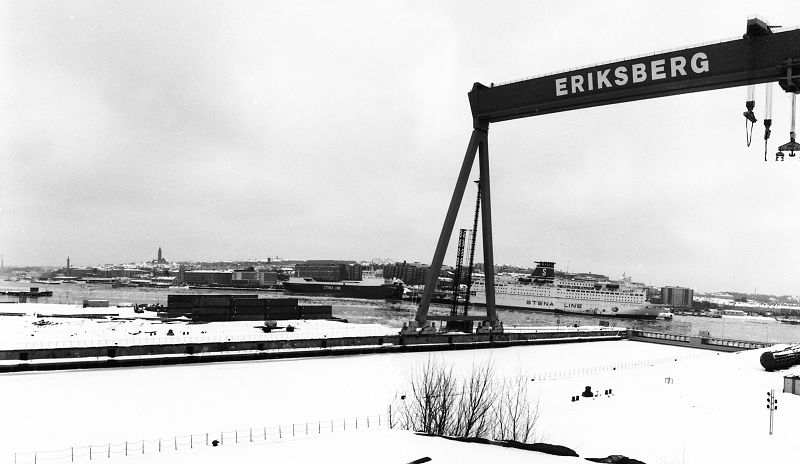
The old Eriksberg shipyard and its launch bed #6 where we would build our own 'Terra Nova'.
It is the first winter of the project and the year is 1992 to 1993. Never, I though when I took this picture, will the East Indiaman Gotheborg III feel further away than this. From now on, every step of the way would take us closer to the sailing ship.
Photo: Jan-Erik Nilsson, 1992.
We in the early core organizing committee had begun holding weekly meetings in an old house called Skateberg, at Lindholmen to keep things moving and to report on our progress. This routine provided a framework for the project, even though we were lacking pretty much everything. Mostly, it was Anders who continued to travel and lecture to groups of people and potential sponsors. Joakim Severinsson presented the rib plan of our future ship, drawn by Chapman, but it needed to be scaled down to fit the dimensions of the Gotheborg.
Today, Anders had exciting news. He had met with Bengt Tengroth, the head of Eriksbergs Utvecklings AB, and secured the rights to use a piece of land at the old Eriksbergs shipyard area. They planned to eventually build on this land, but in the meantime, we were welcome to construct our ship there.
When going home from this very meeting, Anders and I stopped to inspect our future shipyard location. In my mind's eye, I could already visualize the wooden ribs of the hull rising against the snow-grey sky at the launch bed #6 near the black row of containers left from a theater project. I remember feeling no doubt about our ability to accomplish this. Personally, I had thought that finding a waterside location for the shipyard would be the most challenging part of the endeavor. Now, with the issue of "location" ticked off, there would only be a few more practical details to tend to and we would have our ship.
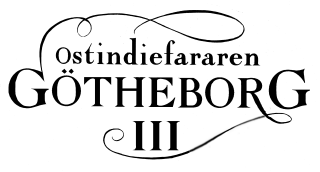
The first logotype for the Ship Building part of the project is drawn by Jan-Erik Nilsson, based on the cover of the original 'Ledger A' of the Swedish East India Company, preserved in the Regional Archive in Gothenburg, where some of the documents from the first periods of the Swedish East India Company 1731-1813 are kept. In 2003, this logotype was eventually reproduced on stamps issued by the Swedish Post commemorating "Ostindiefararen". This logotype was later replaced with one supplied by Forsman & Bodenfors, that included a sailing ship.

Terra Nova Shipyard, summer of 1993. Here we would build the shipyard. We were firmly determined that on this muddy piece of industrial wasteland we would build a ship that would sail to China. But, first we needed a shipyard. To the right, Anders Wästfelt describing the layout of the shipyard.
Photo © Jan-Erik Nilsson, 1993.
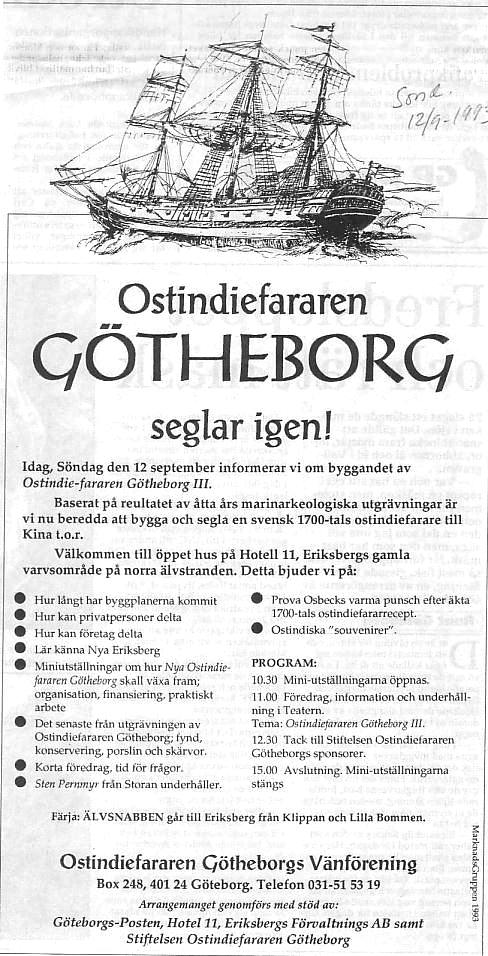
September 12 1993, public announcement towards an information's meeting at Hotel 11. Official start of the project.
Advertisement design: Jan-Erik Nilsson, Sept 1993.
By 1993, public interest in the East Indiaman Gotheborg III project was immense. The Friends organization had thousands of members, and the Swedish business community, both domestically and internationally, was keenly aware and supportive.
Our long-term plan was ambitious. I recall Anders, presenting it to sponsors, humorously questioning his own lifespan in relation to the project's completion. Also, on the side aisle of the Hotell 11 theater were our presentation was held, the Gothenburg business profile Erik Wettergren, whose father had founded the Wettergrens Books store in 1882, exuded enthusiasm and conviction from the audience.
November 5, 1993. The Management Group sets out to organize the East Indiaman Götheborg III Foundation to assume the overall responsibility for the project and to become the beneficiary of the donations that will be needed to fund the project. More than 40 friends and sponsors are invited to become Founding Fathers to resume the sole responsibility to oversee the activities of the foundation and to that end to have the right to select the members of the Board of Directors of the Foundation, at a yearly meeting.
December 28, 1993. The Management Group asks the Friends to donate the funds necessary for the Foundation to register the The Swedish East India Company AB as a fully owned company, to build the ship. The Friends donates 100 percent of the shares of the SOIC AB, to the Foundation.
All in all the Friends were able to donate close to 200,000 SEK during 1993 to get the project started, including the capital needed to create the Swedish East India Company, SOIC AB.
In February 1994, about 130 companies had pledged some form of sponsorship. All who saw current or future value in the project were invited to support it. This approach led to the shipyard's construction and the project's full commencement within five years.
However, larger Swedish export companies remained cautious. Our immediate task was to get the project off the ground and prove its viability. If we could demonstrate success, we were confident of gaining their support.
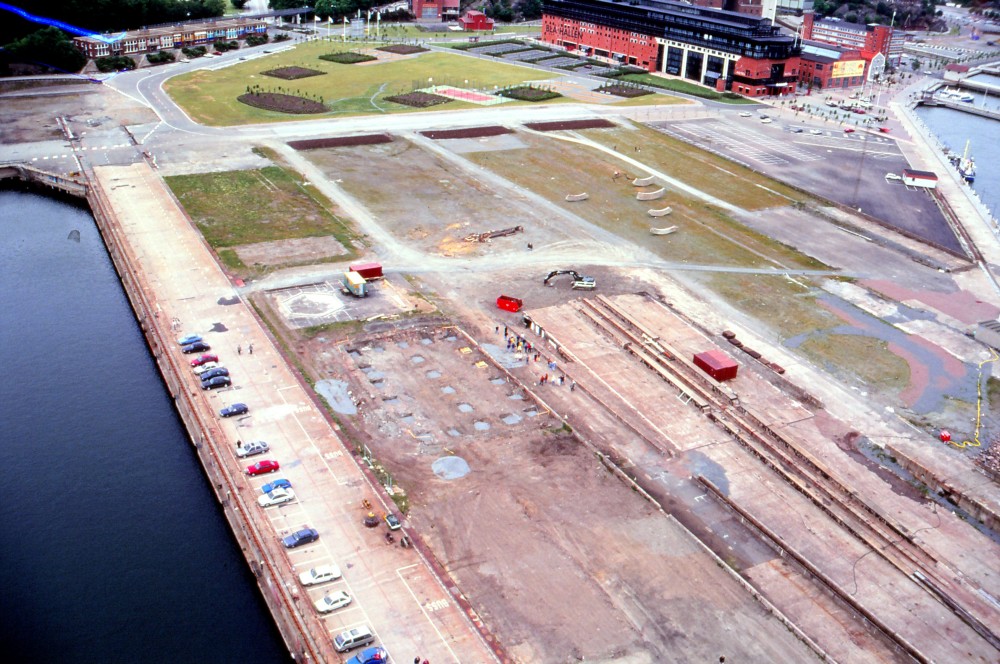
Former Eriksberg Shipyard area with Slip Bed #6 (right) as seen from the 84-meter-high gantry crane, soon to be our new 'Terra Nova' shipyard, named after the shipyard in Stockholm where the original Götheborg was launched and equipped 1737-1738. The light-colored circular area along the dockside cement road is where the smithy will be erected. The twenty two regular gray dots are the foundation for the ribs' workshop and sail loft.
Photo © Jan-Erik Nilsson, 1994.
In 1994 the members of the Friends Organization together with hundreds of voluntary workers and supporting companies starts the building of the new shipyard Terra Nova at Eriksberg.
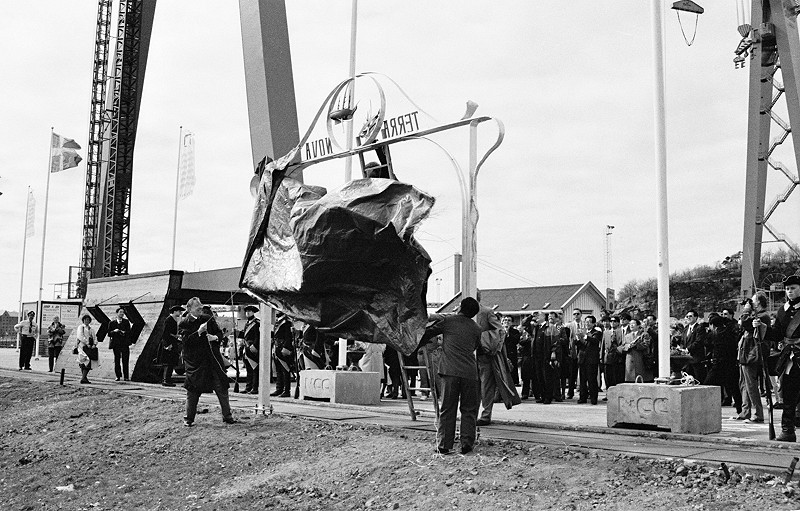
Terra Nova Shipyard gate was erected immediately ahead of official inauguration, July 1994.
Photo © Jan-Erik Nilsson, 1994.
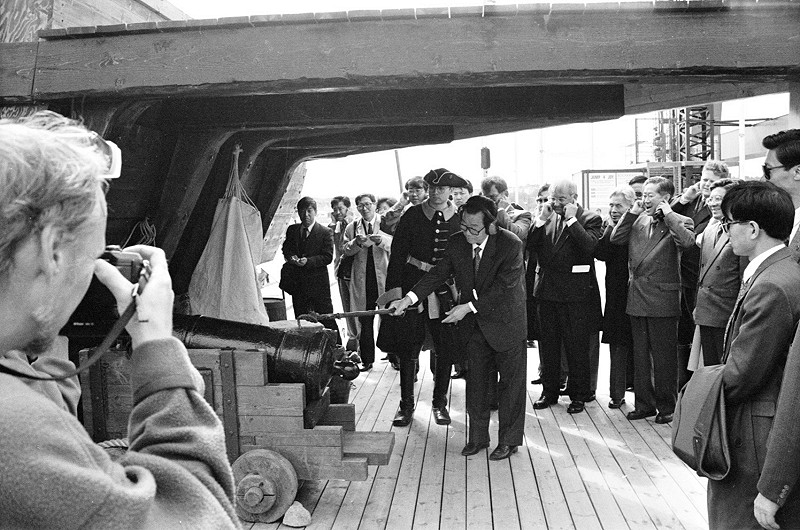
In May 7, 1994 The Chairman of the Chinese People's Congress, Mr. Li Ruihan inaugurate the Terra Nova shipyard area.
The Gate is made by Bert Johnsson and is now the only standing structure on the Shipyard area.
Photo © Jan-Erik Nilsson, 1994.*
General Hull and Rigging plan decided
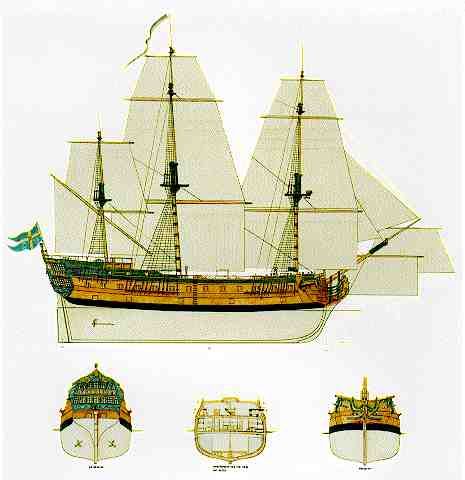
The General Hull and Rigging plan is drafted. The hull is drawn by Joakim Severinsson,
The rigging is designed by Olof Pipping. The fore and aft ship decoration drawing, by Roland Rydén.
At the meeting of the Management Group it was decided that the ship would have a hull of wood, about 75% oak and 25% pine. In order to provide enough strength, the frame-timbers would be made from laminated pine. The keel, stem, stern, beams, planks, trimmings and other framework details would be made from oak. The decks would be of pine. The sails and the standing and running rigging should be made with traditional materials, mainly hemp.
The hull would be constructed with as much historical accuracy as possible outboard as well as inboard above the free board deck. The hull would be divided into six waterproof sections for safety and in order to limit any possible damage.
Beneath the free board deck, no consideration of historical tradition would need to be taken, but the design and materials used would still be in keeping. The deck machinery would be as historically correct as possible. The ship was to be ballasted to obtain the historically correct waterline and carry 80 persons in crew, officers and trainees, and 12 passengers.
June 11, 1995 the official laying of the keel takes place in front of 3.000 spectators. The ceremony is performed by Sören Gyll, Volvo AB, Professor of History Jörgen Weibull and Alf Österström, Priest of the local congregation. Two coins are placed in each of the two joints of the 33 meters long oak keel. Three years later the Friends Organization, the Management Group and a huge numbers of volunteers, brilliant ships builders and carpenters can proudly show they are well on their way doing the impossible.

The keel of the ship consists of three separate parts made out of the best possible straight grown oaks. Here one of the joints - lask - is prepared. The keel have two of these joints. In each of these a coin was placed for good luck, each respectively representing the history, upon which our now and future, is built.
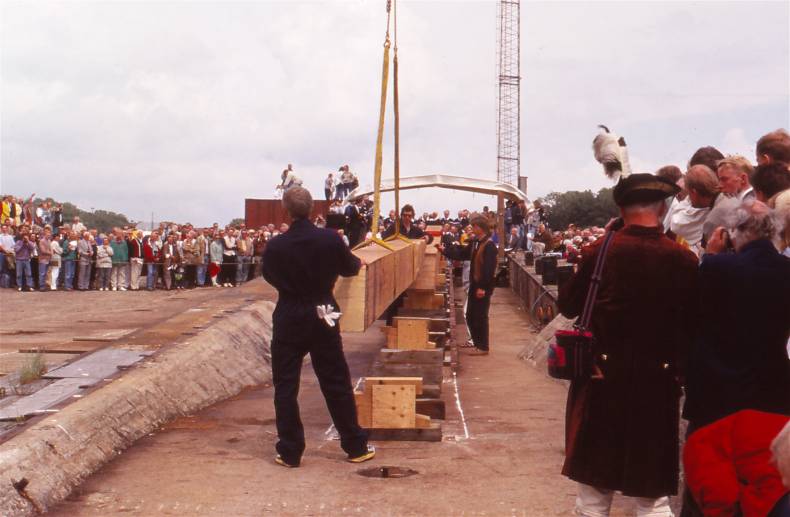
In 11 June 1995 the keel that was made of three large sections of oak was officially laid out and joined.
This was done in the open air, ahead of time, before the ships hall was erected. I am not sure we had the money for the ships hall at this moment.
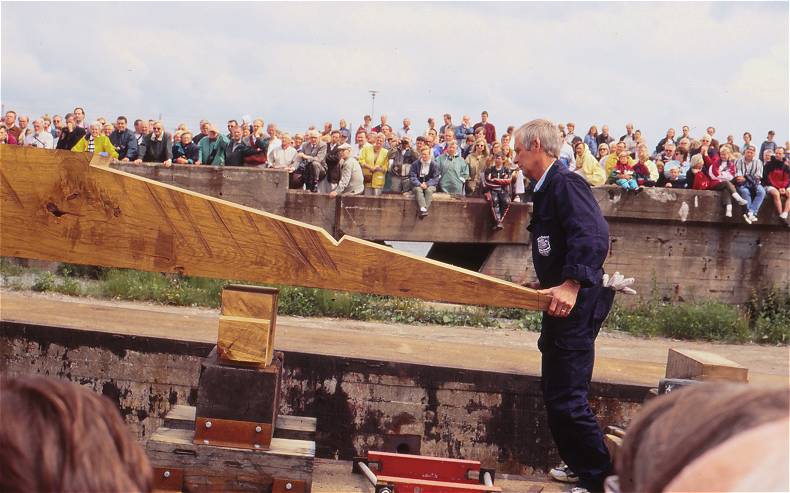
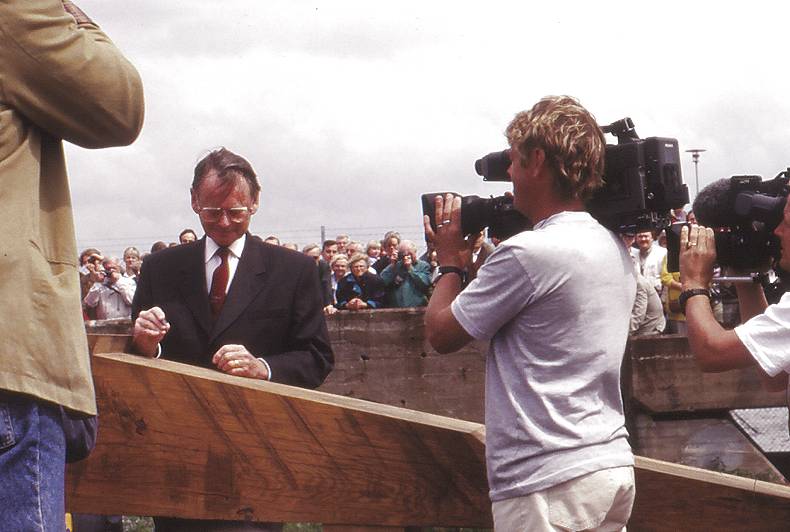
Professor Jörgen Weibull fits one coin from 1745 in one of the two joints of the 33 meters long oak keel
for good luck, and to represent the history. Photo: Jan-Erik Nilsson, 1995.
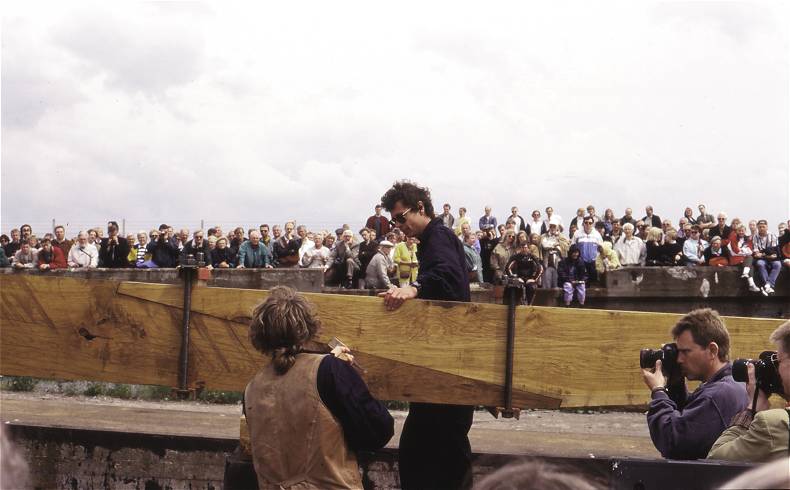
In 1996 the shipyard hall is built. Wood beams from an old building elsewhere are found that will fit our purpose perfectly are found and a light tin roof is built across the beams. On each side of the old slip way there were eleven plinths cast in reinforced concrete to support large beams that are to form the roof over the ships hall. The beams came from an old building in Skandiahamnen and was donated to us by the Gothenburg Harbour AB. The covering of the hall with a light tin roof, we eventually needed to contract and pay for, but the rest was sponsored. It could not have become better or more fitting even if we would have had the building especially designed for our purpose.
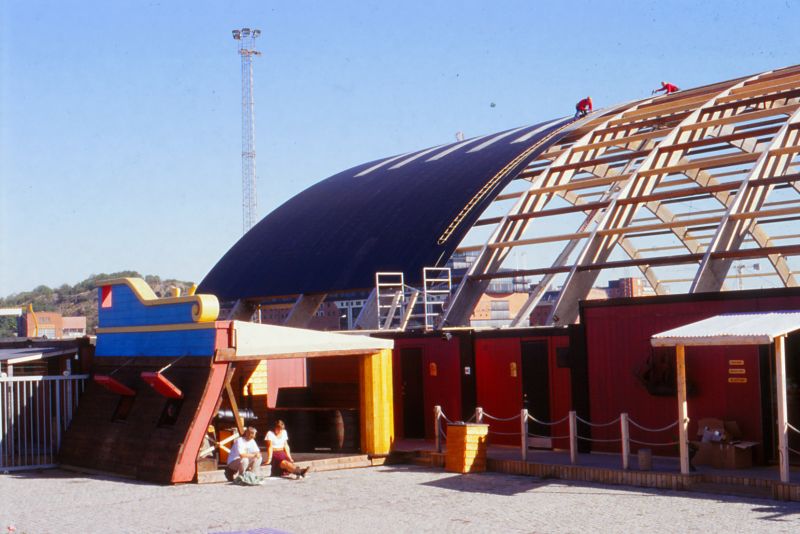
In 1996 the shipyard hall that will cover the hull is raised and covered with a roof. To the left is a scale model of a section of the canon deck, to give visitors an idea of the proportions of the Gotheborg, with the guide Karin Mojzis. To the right, the first Terra Nova souvenir shop.
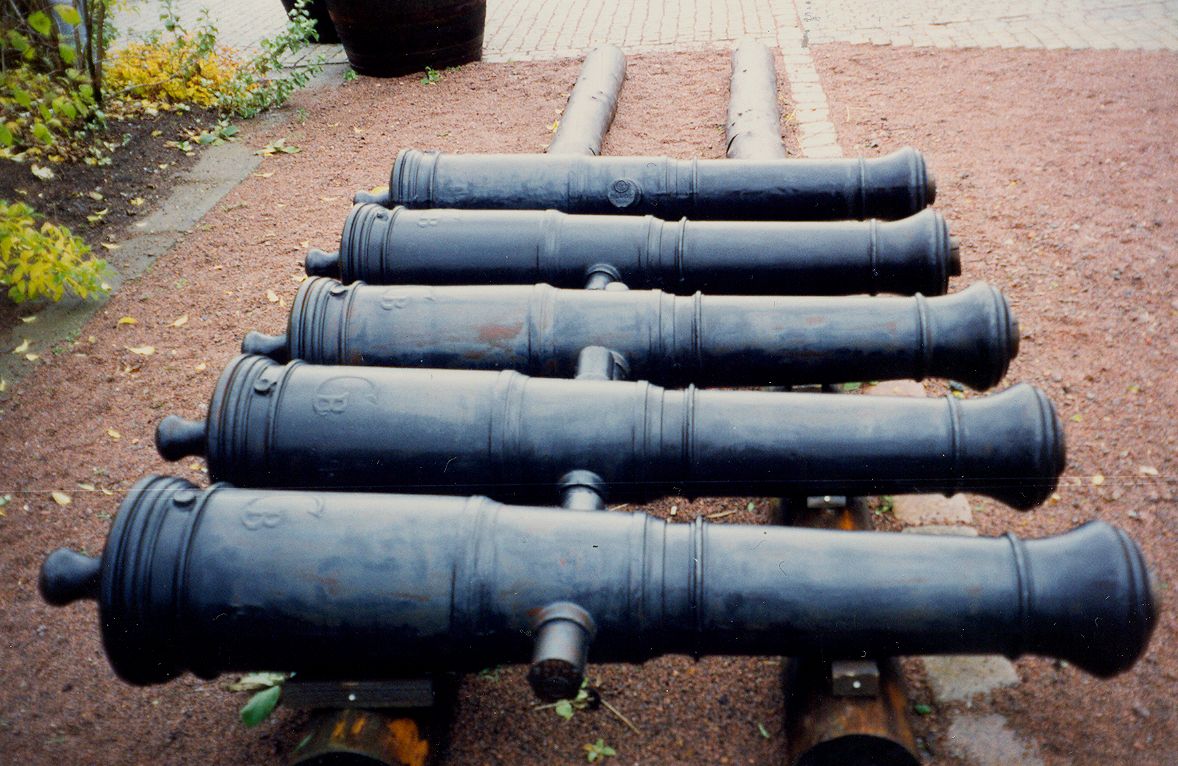
Already in 1996 DAROS sponsored us with the canons needed for the future ship
They wanted to help, but would soon relocate to a new factory where this kind of castings would not be possible any more so the canons arrived to the shipyard even before the first rib was raised.
Photo: Jan-Erik
Nilsson, September 1998
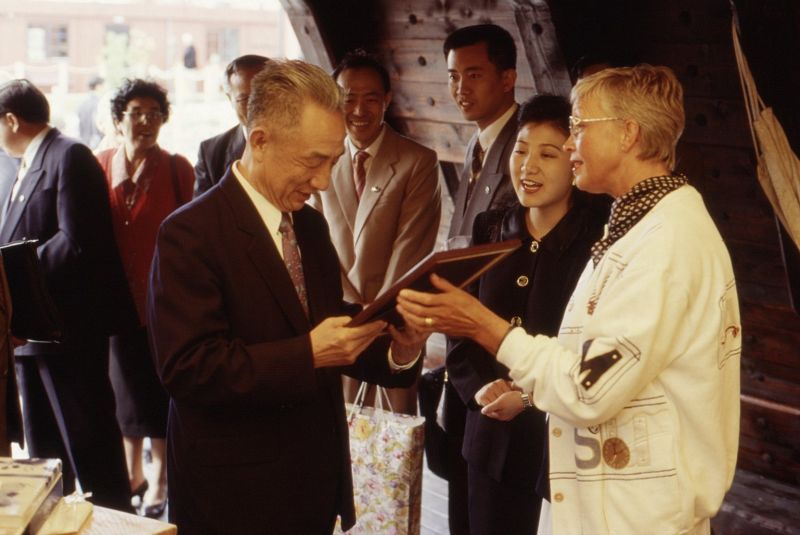
The 4th of June 1996, Terra Nova is visited by the Vice Premier of China, Mr. Zou Jiahua ho is given the Ticket no 1 for the last leg to China with the East Indiaman Gotheborg III, "as soon as we have built her".
The 4th of June 1996 The shipyard is visited by the Vice Premier of China, Mr. Zou Jiahua together with the Chinese Ambassador to China, Mr. Yang Guirong and the Swedish Ambassaor to China, Mr. Sven G. Linder. Later the same year the Major of Shanghai, Mr. Xu Kuangdi visits the Shipyard. The 8th of December 1996, the first rib is officially raised.
Major of Shanghai, Mr. Xu Kuangdi visits Terra Nova
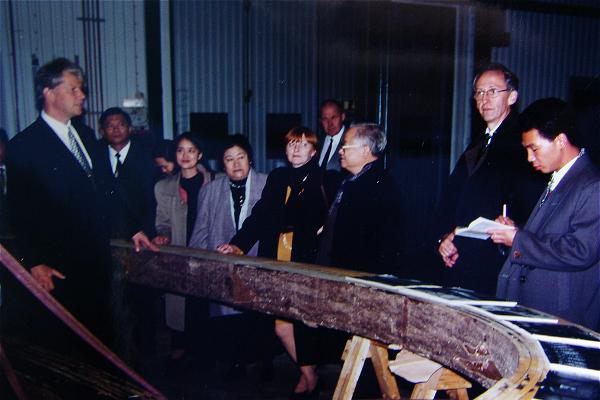
Jan-Erik Nilsson (left) presents the rib manufacturing process to the Major of Shanghai, Xu Kuangdi with entourage. To the far right, Nils Olof Ericsson, official interpreter to the Swedish Ministry of Foreign Affairs.
Anders and I are extensively interviewed about the purpose, plans and progress of our project ahead of the then Swedish Prime Minister Göran Persson's visit to China the on 2-4 November 1996.
We are now convinced that our project would soon, finally, receive some kind of public recognition and ideally some kind of financial support, but, no.
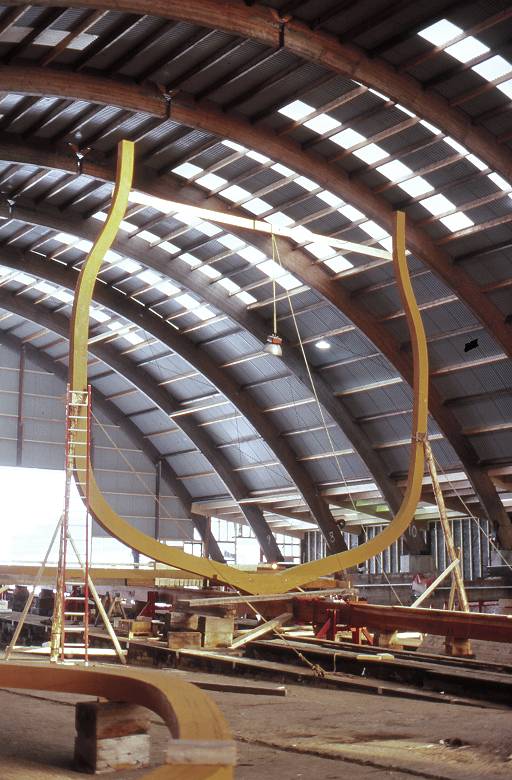
The 8 December 1996 the first rib is erected. A much looked forward event is held inviting anybody interested via advertisements in GP, organized and run entirely with volunteers, mostly from the 'Friends' organization. Around fifty persons are helping with reception, serving and guiding of about 3,000 guests.
First East Indiaman Gotheborg IT fair occupying 1500 square meter area - the entire G Hall - at the annual Boats Show at Svenska Mässan. Nils Boijart, Jan-Erik Nilsson and Anders Wästfelt creates a 'Virtual World Tour' focused on the trade route and the cultural and commercial purpose of the project. The whole world participates via Internet and interactive webcams.
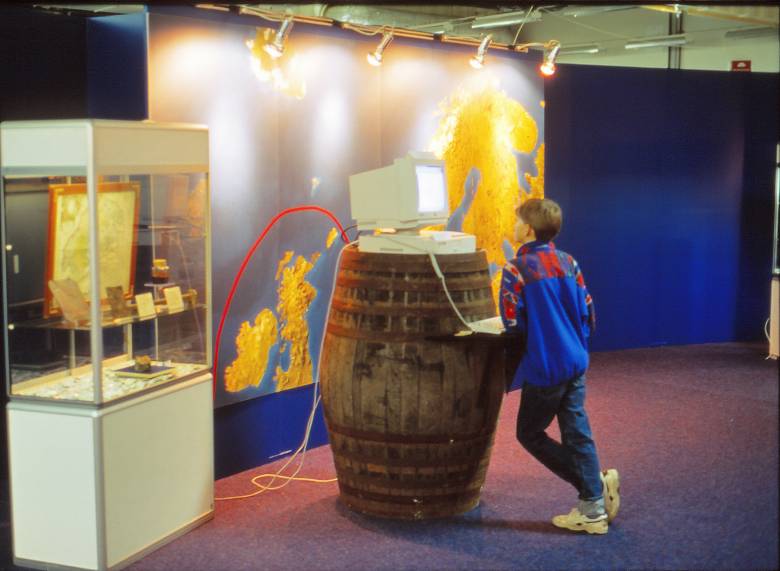
Ahead of the Boat Fair opening day, our volunteer Internet programmer to the project, my son, David Nilsson, studies the "North Sea Destination" on one of the Virtual Tour monitors, sponsored by Siemens, connected to a state of the art network at Svenska Mässans G-Hall, Gothenburg. The youngest generation immediately understands the connection between old and modern world traveling.
At this fair we pioneer World Trade Portals at the Internet. Photo: Jan-Erik Nilsson, February 1997.
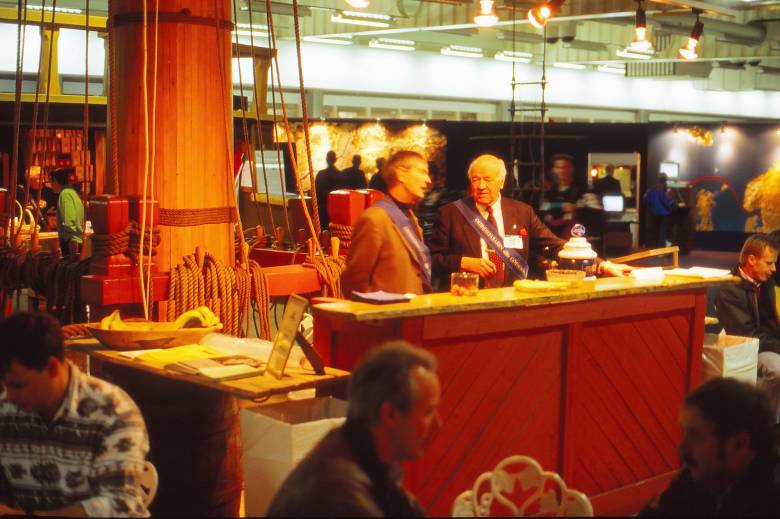
On Svenska Mässan's Boat Fair 1997 our high tech internet 'virtual tour' attracts the younger visitors
while the old timer enjoys the smell of tar in our inside-out globe shaped exhibition. Photo: Jan-Erik Nilsson, February 1997.
Minister of Trade Leif Pagrotski visit Shanghai and the Gotheborg project web pages at gotheborg3.se are a sensation. They are the first web pages in the world produced in the west with information directed to China - in Chinese. The pages are shown to 15-20 millions of viewers in Shanghai TV. Lars Åke Skager can at a meeting with Governor Göran Bengtsson in Gothenburg tell the Swedish Ambassadör Sven G Linder and a number of western Swedish managers that the Swedish delegation the next day received an astonishing reception by the Major of Shanghai, as he saw it, thanks to our web pages.
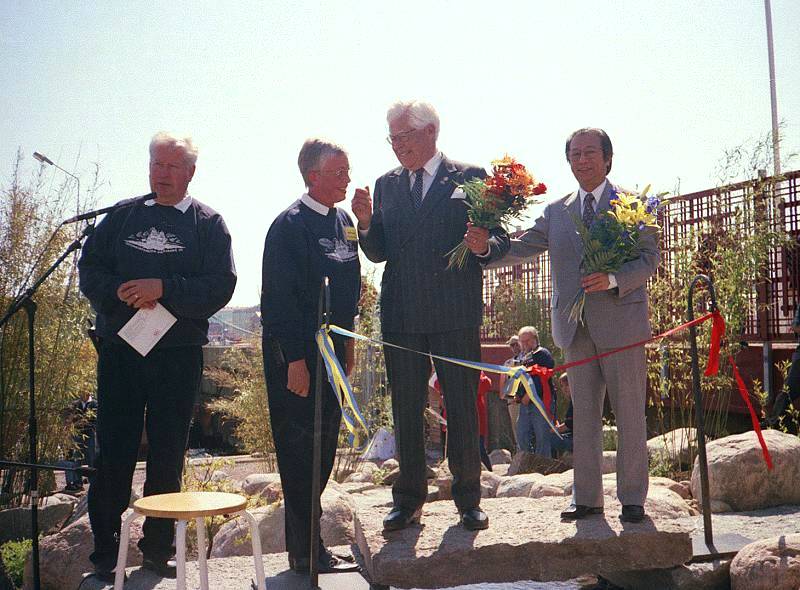
On May 22 the Chinese Garden at Terra Nova was inaugurated. A large number of members of STAF had contributed the work. The inauguration was done by a unique ceremony where the 'Friends' Chairman Erik Wettergren, tided together a Swedish silk ribbon with a Chinese. From the left Anders Wästfelt, Berit Wästfelt, Erik Wettergren and the Chinese Consul General in Gothenburg Tan Jianlun. Photo: Jan-Erik Nilsson, May 1997.
During the year 1997 the ships ribs are made and erected one by one.
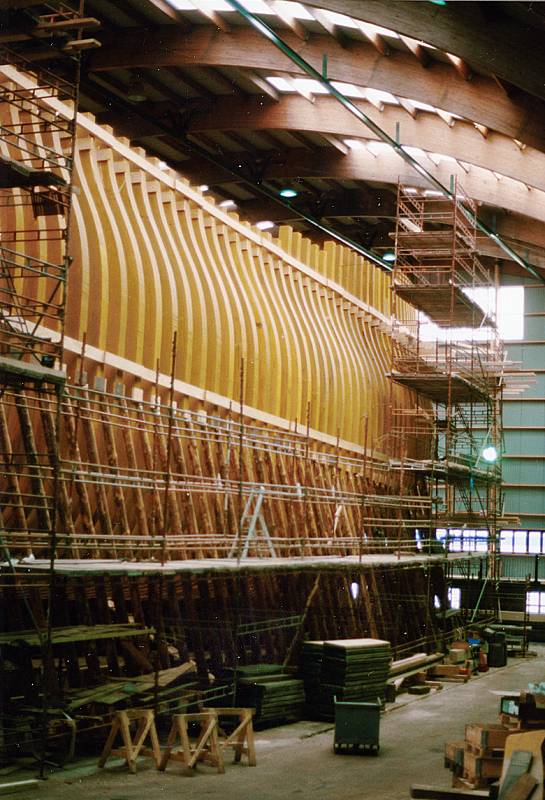
The 12 November 1998 the 66th and last rib was raised. Photo: Jan-Erik Nilsson, 1998.
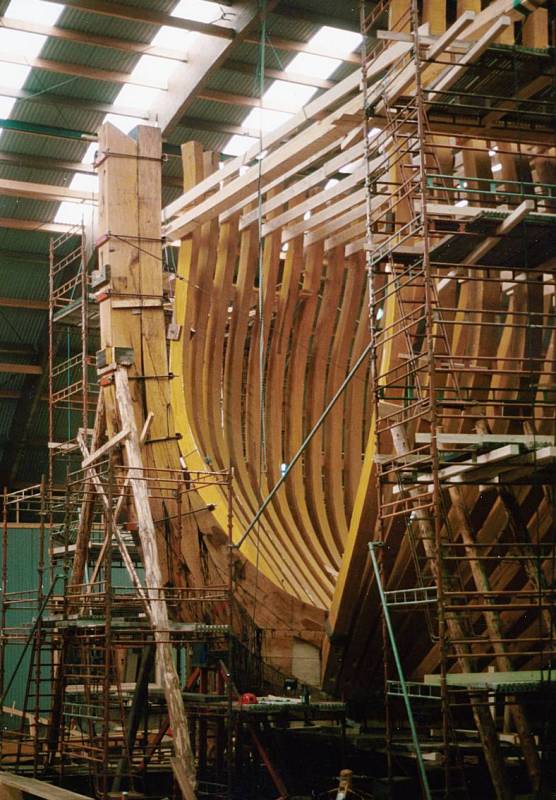
The 12th of November 1998 the 66th and last rib is raised. The ship's main inner structure is now finally complete. From now on the the organization changes focus onto the ship building only. The project initiators find themselves not needed or actually not wanted any more.
Since we were never hired or paid by anyone to do this, there are also no traditional ways of 'managing' us who in realty were running the entire project. We find that we have created a level of management higher then ourself, who now finally want to take over - SOIC AB and the Gotheborg III Foundation and thus as it turns out, in effect also given away the ship.
Since almost all sponsors are there to support the larger purpose of the project as originally visualized by us, the original initiators meaning basically Me, Anders and Berit Wästfelt and the larger Group of the Friends organization, the project now gets delayed for a several years since the project don't have any commercial financing or share holder capital to rely on, except us, the volunteers and the sponsors.
Eventually the official Sweden warmed up to the idea, and eventually started to promote our project, as their own.
Maybe this was inevitable and maybe that was what we ultimately had wanted however, we were not ok with the ham handed way it was presented, or pushed through. We can even set a date on, when we got this 'offer we couldn't refuse'. However the project wasn't ours to give away just like that, so we of course refused, and of course that didn't change a thing.